The end of a drought brings amazing flower displays–both in variety and in number. Here are a few of our beauties, up close:
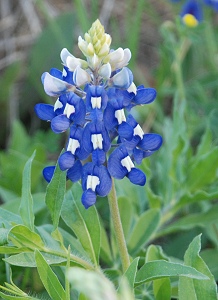 I have to start with the Texas Bluebonnet (this is an early bloom; they’re now just past peak.) We have some sports on our place that I don’t remember seeing before–I don’t know if the drought did it or something else:
I have to start with the Texas Bluebonnet (this is an early bloom; they’re now just past peak.) We have some sports on our place that I don’t remember seeing before–I don’t know if the drought did it or something else:
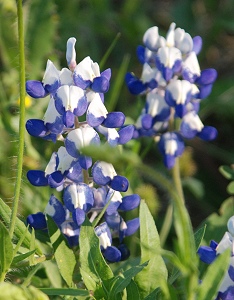 Here the neat white square in each blue flower–that makes masses of them look almost like blue and white checked gingham–extends to the top of the top petals, producing a very different look. Gaudy, but I prefer my bluebonnets in the old style. However, this new color pattern showed up in multiple locations, so we may be stuck with it.
Here the neat white square in each blue flower–that makes masses of them look almost like blue and white checked gingham–extends to the top of the top petals, producing a very different look. Gaudy, but I prefer my bluebonnets in the old style. However, this new color pattern showed up in multiple locations, so we may be stuck with it.
Here, it’s growing up in the dry woods, mixed with more normal bluebonnets and a little yellow daisy-like flower I haven’t IDed yet. (We have lots of yellow flowers of that type. Takes patience and time to sort them out.)
This has been a good year for stiff-stem prairie flax, which brightens any other flowers around it.
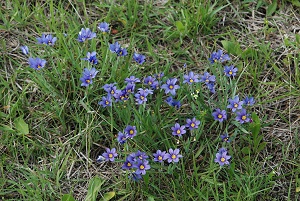 And it’s been a spectacular year for blue-eyed grass–this is an image from earlier in the month–nosegay after nosegay of these little flowers–hard to walk on the paths without stepping on some. Usually they’ve given up by now, but this year, with the rain all winter, they’ve kept blooming. Some clumps are almost a foot high and a foot wide, a mound of blue-purple in varying shades.
And it’s been a spectacular year for blue-eyed grass–this is an image from earlier in the month–nosegay after nosegay of these little flowers–hard to walk on the paths without stepping on some. Usually they’ve given up by now, but this year, with the rain all winter, they’ve kept blooming. Some clumps are almost a foot high and a foot wide, a mound of blue-purple in varying shades.
Fleabane is one of the open prairie plants that blooms well into the summer, with some rain.
Gaura flowers at the top of slender stalks that sway in the wind, making a shifting salmon/pink/white veil over shorter flowers below.
Greenthread glows–it seems to catch and hold sunlight more than most of the other yellow flowers.
Texas sage plants are small, but covered with intensely blue flowers on their soft fuzzy foliage.
White Rocklettuce grows on the rockier upland soil, and here is emerging from an elbow-bush, the first time we’ve seen it in this location (we had a patch about 50 yards away, downslope, so I’m guessing a bird transported the seed.) Besides the bluebonnet, you can just see the seed-spikes of a Texas cranesbill (past blooming.)
A Hesperaloe (“red yucca”) is about to bloom, surrounded by normal and splash-white bluebonnets and greenthread.
Here a lacy carrot-family flower (not sure which), a yellow daisy-like flower, and bluebonnets share a corner of prairie near the dry woods.
More flowers as they come and I get pictures.
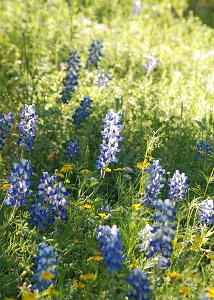
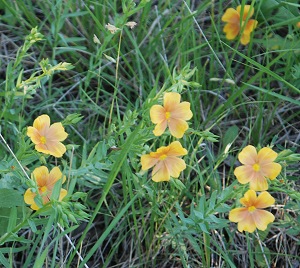
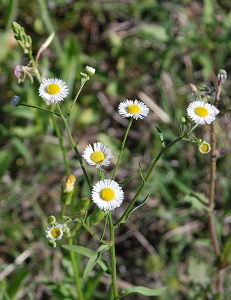
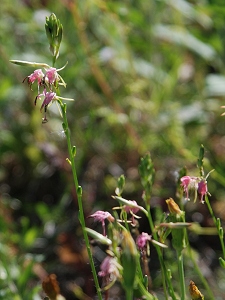
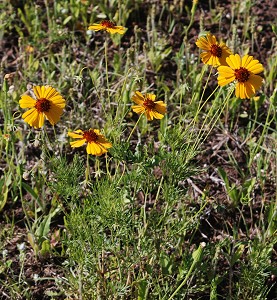
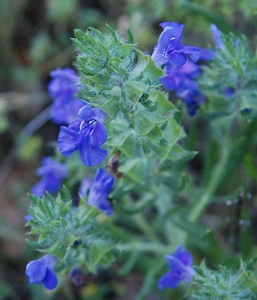
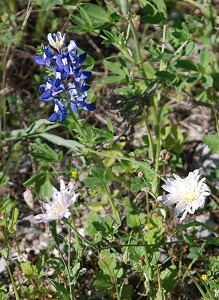
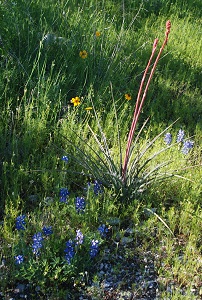
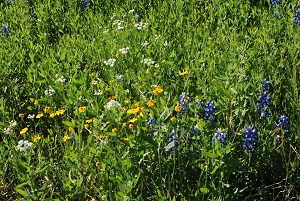
Comment by Caryn — April 27, 2010 @ 2:36 pm
Gorgeous.
Comment by AJLR — April 28, 2010 @ 3:22 pm
Such beautiful colours and shapes those flowers are. I wonder how they look to insects, in the ultraviolet that some of them see in?
Comment by Martin LaBar — April 29, 2010 @ 3:38 am
Splendid, all of them.
Comment by elizabeth — April 29, 2010 @ 10:11 am
I’ve seen photographs using special filters or film that showed more ultraviolent, and most flowers have “lane markers” to guide insects right where the flowers want them. (No, I’m not REALLY personifying flowers–yes, it’s evolution.)
Comment by Katrina — May 2, 2010 @ 1:20 pm
Thanks for the pictures. You have an almost totally different set of wildflowers from the ones we have here in Pennsylvania.
Comment by elizabeth — May 2, 2010 @ 1:34 pm
When I lived for three years on the East Coast (northern Virginia) I recognized almost none of the flora. It was amazing (and in the long run, a delight) to see all the things that had been in my schoolbooks in south Texas (where none of those things will grow.) Finally, on a dry slope in the “ridge and valley province” in West Virginia, I spotted a prickly pear–at least I knew that one without looking it up!
Glad you’re enjoying the pictures. Today I saw a field of mealy blue sage in bloom, along with some of the yellows–like blue mist over the ground with splashes of brilliant, intense yellow.